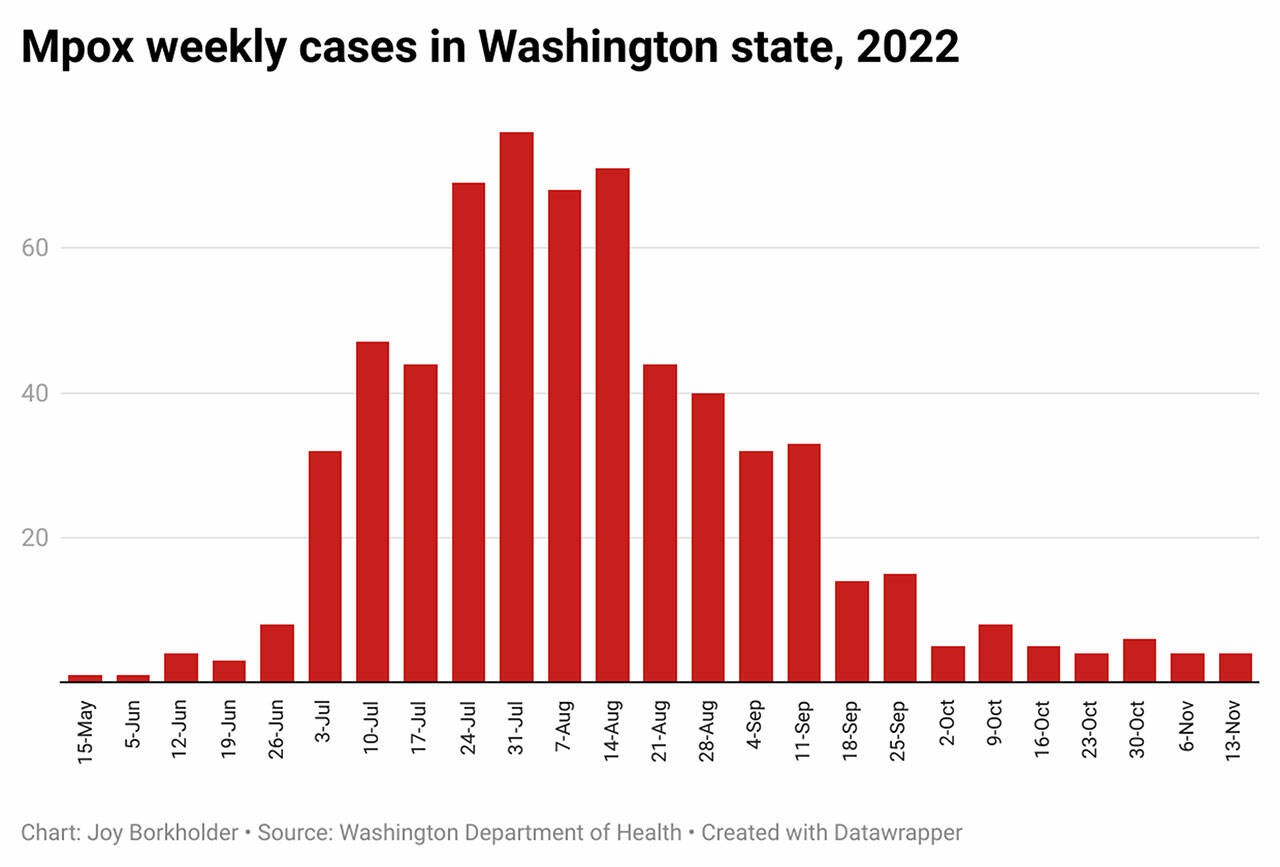EVERETT — Snohomish County hasn’t had a new case of monkeypox in two weeks, as the virus now known as mpox has waned here and across the nation.
The U.S. Department of Health and Human Services announced this month it will not renew the public health emergency declaration for mpox. Nationwide, cases have declined by 95% from their peak.
Dr. James Lewis, health officer for the Snohomish Health District, said it’s “reasonable” to end the public health emergency, given the decline in cases.
Overall, state health numbers show Snohomish County has seen 35 cases, or 5% of the statewide count of 644 cases. Statewide, the virus is blamed for 18 hospitalizations and no deaths.
With a count of less than 10 new cases per week over the past two months across the state, the trajectory appears much better than when the weekly total peaked at 76 during the first week in August.
Mpox is a virus that causes rashes and other symptoms, such as fever and a headache. It is spread through close contact such as with body fluids and even respiratory droplets. While most people recover in two to four weeks, the virus can cause serious complications for people with compromised immune systems, children and pregnant people. Such complications can include secondary infections, sepsis, encephalitis and loss of vision, according to the World Health Organization.
In Washington, the state Department of Health, local health departments and tribal partners have collaborated to make the limited doses of the JYNNEOS vaccine accessible to the highest-risk communities. That includes several categories, notably anyone who has had close contact with someone diagnosed with mpox.
Others considered high-risk in the recent outbreak are “gay, bisexual, or other men or transgender people who have sex with men and who have had multiple or anonymous gay, male bisexual, or transgender sex partners in the last 6 months.” Lewis added that state data shows Black and Latino/x folks have also been disproportionately affected.
Nearly 18,000 people statewide have received at least one dose of an mpox vaccine. Snohomish County residents account for 736 or 4% of vaccine recipients.
People interested in the vaccine can start by filling out a form on the health district’s website.
Lewis said the official end of the emergency doesn’t mean much for the county’s efforts. The health district will continue outreach and education, particularly in communities disproportionately affected by mpox. They will just do that work with fewer resources, he said.
Although he looks forward to having more resources when the district merges with the county to become the Snohomish County Health Department on Jan. 1.
And Lewis added that this isn’t the last public health emergency, nor is it likely the end of mpox. The county needs to be able to react quickly, providing community vaccine clinics, for example — something the health district did not pull together for mpox.
“I really think the focus needs to be that we need to strengthen the public health infrastructure to respond rapidly and effectively with flexible and dependable funding sources,” Lewis said.
Resources:
Snohomish County resources, including the vaccine form: snohd.org/691/Monkeypox
Statewide news and data: doh.wa.gov/you-and-your-family/illness-and-disease-z/monkeypox
Joy Borkholder is the health and wellness reporter for The Daily Herald. Her work is supported by the Health Reporting Initiative, which is sponsored in part by Premera Blue Cross. The Daily Herald maintains editorial control over content produced through this initiative.
Joy Borkholder: 425-339-3430; joy.borkholder@heraldnet.com; Twitter: @jlbinvestigates.
Talk to us
> Give us your news tips.
> Send us a letter to the editor.
> More Herald contact information.

























